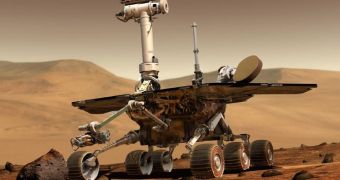The NASA Mars Exploration Rovers (MER) Spirit and Opportunity will receive a lifetime achievement award on October 10, during a ceremony to be held in New York City. The fact that the mission will receive this Breakthrough Award was announced on October 3 by Popular Mechanics magazine.
Originally, the two machines were scheduled to drive a few hundred meters, and analyze rocks around their respective landing sites. However, Spirit managed to endure for nearly 7 years, until mission managers at the NASA Jet Propulsion Laboratory (JPL) lost contact with it, in 2010.
This was to be the rover's fifth Martian winter. However, contact could not be reestablished earlier this year. On the other side of the planet, its twin Opportunity fares a lot better. It will soon turn 8 years old on the Red Planet, having worked nonstop since 2004.
In recognition of these impressive achievements, MER engineers and rovers will be honored with the Breakthrough Award “for overcoming great challenges in their dogged pursuit of new discoveries on the Red Planet,” the magazine says in its announcement.
These machines and the science team managing them “turned a 90-day mission into one of space exploration's longest-lasting adventures, making stunning discoveries about the Red Planet along the way,” the announcement further states.
Popular Mechanics decided to award the Breakthrough Mechanical Lifetime Achievement Award to MER principal investigator Steve Squyres (Cornell University), MER mission manager John Callas (JPL), and former mission managers Peter Theisinger and Richard Cook (JPL).
Spirit drove a total of 4.8 miles (7.7 kilometers) until it became embedded in Troy, back in early 2010. However, Opportunity is the leader in this race, having already traveled more than 20.8 miles (33.5 kilometers). It is now perched on the rim of its target for 3 years, Endeavour Crater.
The first rover, Spirit, arrived at Mars on January 4, 2004, but remained non-operational for 10 days, as JPL experts struggled to repair a fault in a flash memory subsystem. Its twin spacecraft arrived at the Red Planet on January 25.
The sheer amount of data the two machines sent back forwarded our understanding of our neighboring planet considerably. Experts argue, and rightfully so, that NASA would have had to send an extra 20 missions to accumulate these information, where the rovers only function for three months.

 14 DAY TRIAL //
14 DAY TRIAL //